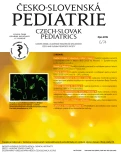What are the possibilities of breastfeeding support after early cleft lip repair in the Baby-Friendly Hospital?
Authors:
I. Burianová 1,2; V. Halašková 1; J. Borský 3; J. Janota 1,4
Authors‘ workplace:
Novorozenecké oddělení s JIP, Thomayerova nemocnice, Praha
1; Pediatrická klinika 2. LF UK a FN Motol, Praha
2; Klinika ušní, nosní a krční 2. LF UK a FN Motol, Praha
3; Ústav patologické fyziologie 1. LF UK, Praha
4
Published in:
Čes-slov Pediat 2019; 74 (6): 349-353.
Category:
Original Papers
Overview
Aim of study: The goal of early repair of facial cleft defects is to enable optimal development of the following: speech, hearing, suction and facial look. Early operation (repair within first 14 days of life) brings easier wound healing and faster improvement of facial deformity without increase of the risk of complications. Early surgery may influence breastfeeding. There is limited information available, regarding breastfeeding rates after early cleft repair. The aim of the study was to assess breastfeeding rates in newborns with cleft lip (CL) and newborns with cleft lip and palate (CLP) after early repair. Assessment was done in Baby Friendly Hospital (BFH).
Methods: We performed retrospective observational cohort study. Included infants were term and near term newborns with cleft lip or lip and palate operated on within first 14 days of life. Breastfeeding techniques education was controlled by the team consisted of lactation specialists, nurses and pediatricians in Thomayer Hospital Prague.
Results: Included were 104 neonates. Isolated cleft lip (CL) was present in 56 newborns (54%), cleft lip and palate (CLP) in 48 (46%). In CL group, 44 newborns (78.5%) were breastfed 3 (5.5%) fed with breast milk via bottle, 9 (16%) formula fed on discharge. In CLP group, 3 newborns (6%) were breastfed, (65%) neonates were fed with maternal breast milk.
Conclusion: The rate of breastfeeding in patients after early repair of the cleft lip was high and comparable with population of healthy newborns. Breastfeeding rate in patients with cleft lip and palate after early repair of cleft lip was low even after breastfeeding support in Baby Friendly Hospital.
Keywords:
cleft lip – cleft palate – breastfeeding – breast milk
Sources
1. Farronato G, Kairyte L, Giannini L, et al. How various surgical protocols of the unilateral cleft lip and palate influence the facial growth and possible orthodontic problems? Which is the best timing of lip, palate and alveolus repair? Stomatologija 2014; 16 (2): 53–60.
2. Murray L, De Pascalis L, Bozicevic L, et al. The functional architecture of mother-infant communication, and the development of infant social expressiveness in the first two months. Sci Rep 2016; 14, 6, 39019. doi: 10.1038//srep39019.
3. Calteux N, Schmid N, Hellers J, et al. Neonatal cleft lip repair: Perioperative safety and surgical outcomes. Ann Chir Plast Esthet 2013; 58 (6): 638–643.
4. Valentova-Strenacikova S, Malina R. Effects of early and late cheiloplasty on anterior part of maxillary dental arch development in infants with unilateral complete cleft lip and palate. PeerJ 2016; 4, 1620. doi: 10.7717/peerj.1620.
5. Tse R. Unilateral cleft lip: Principles and practice of surgical management. Semin Plast Surg 2012; 26 (4): 145–155. doi: 10.1055/s-0033-1333884.
6. Petráčková I, Zach J, Borský J, et al. Early and late operation of cleft lip and intelligence quotient and psychosocial development in 3-7 years. Early Hum Dev 2015; 91 (2): 149–152.
7. Reilly S, Reid J, Skeat J, et al. Academy of Breastfeeding Medicine Clinical protocol #18: Guidelines for breastfeeding infants with cleft lip, cleft palate, or cleft lip and palate, revised 2013. Breast Med 2013; 8 (4): 349–353.
8. Lindberg N, Berglund AL. Mothers‘ experiences of feeding babies born with cleft lip and palate. Scand J Caring Sci 2014; 28 (1): 66–73. doi: 10.1111//scs.12048.
9. Gailey DG. Feeding infants with cleft and the postoperative cleft management. Oral Maxillofac Surg Clin North Am 2016; 28 (2): 153–159. doi: 10.1016/j.coms.2015.12.003.
10. Cohen M, Marschall MA, Schafer ME. Immediate unrestricted feeding of infants following cleft lip and palate repair. J Craniofac Surg 1992; 3 (1): 30–32.
11. Harris PA, Oliver NK, Slater P, et al. Safety of neonatal cleft lip repair. J Plast Surg Hand Surg 2010; 44 (4–5): 231–236.
12. Ústav zdravotnických informací a statistiky ČR (2016). http://www.uzis.cz//en/category/tematicke-rady/children-and-adolescents.
Labels
Neonatology Paediatrics General practitioner for children and adolescentsArticle was published in
Czech-Slovak Pediatrics

2019 Issue 6
- What Effect Can Be Expected from Limosilactobacillus reuteri in Mucositis and Peri-Implantitis?
- The Importance of Limosilactobacillus reuteri in Administration to Diabetics with Gingivitis
Most read in this issue
- The problem of an early diagnostic procedure in neuroinfection – case report
- Functional results of patients with cleft palate between 1993 and 2006 in Moravia I – Epidemiology and surgical results
- False positivity in newborn screening of 21-hydroxylase deficiency
- Antibody-mediated rejection in children after kidney transplantation
